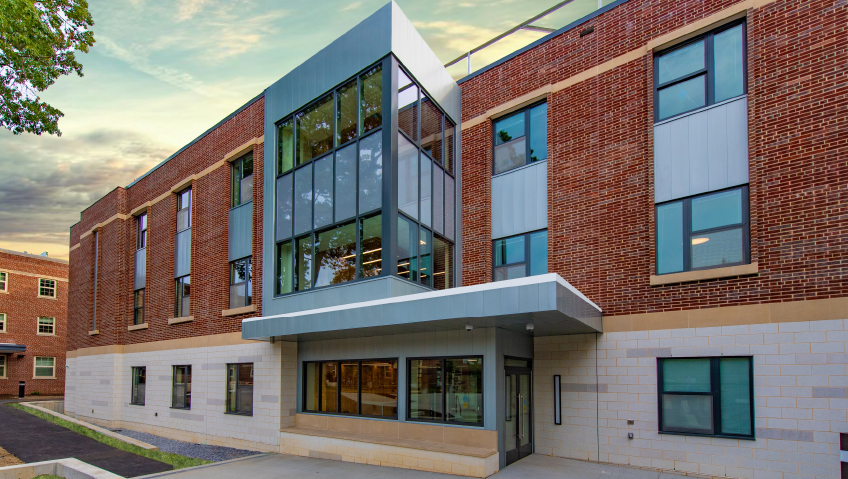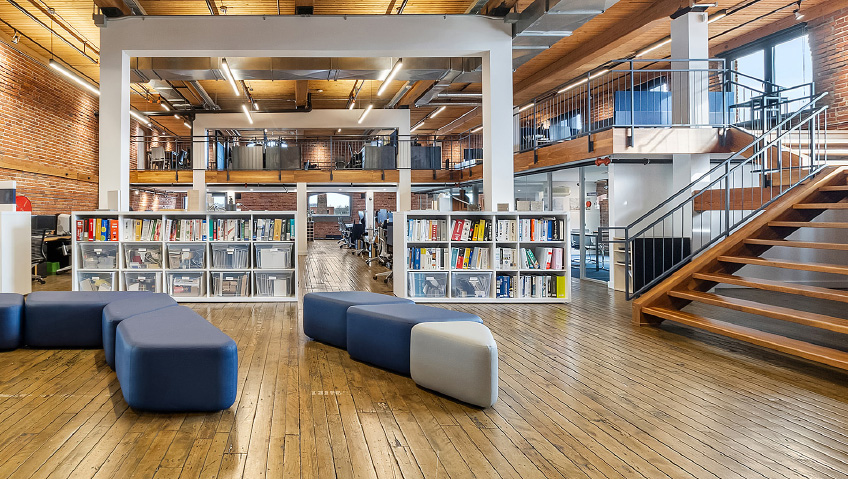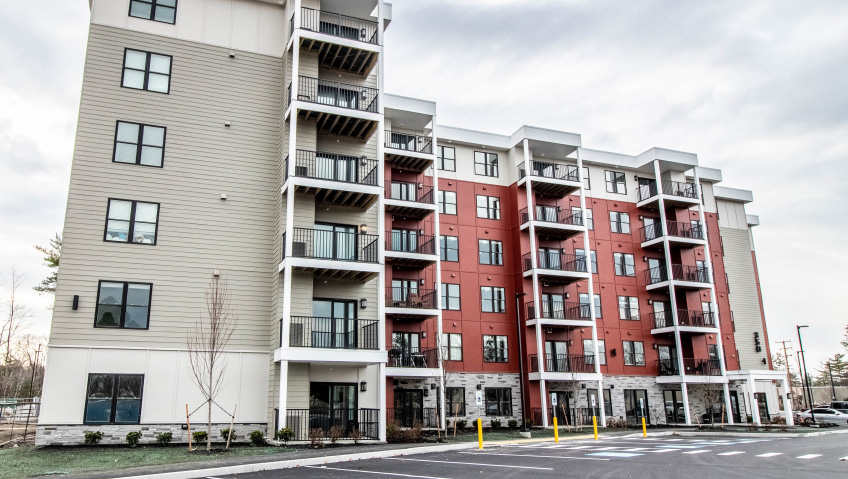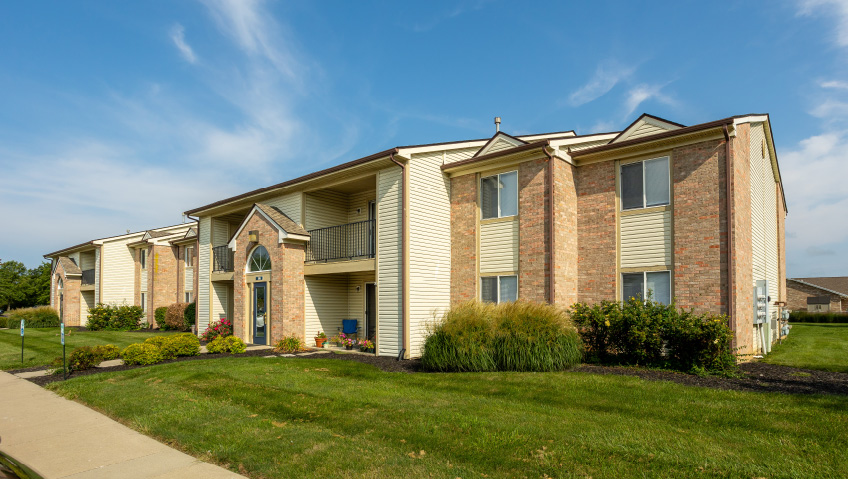It was our pleasure to catch up with John Buongiorno, Director of Axis Construction’s Modular Division in Hauppauge, New York, and Jim Gabriel, the new owner and President & CEO of MODLOGIQ, located in New Holland, Pennsylvania, previously featured in Construction in Focus in 2020. These industry leaders share their experience of the benefits, challenges, and future of modular construction, and a fruitful kind of collaboration.
Gabriel was then Director, Business Development at MODLOGIQ – a manufacturer specializing in customized, complex educational and health-care facilities – which was benefitting from the solid connection and synergy he’d formed with Buongiorno’s division at Axis Construction, which specializes in the same areas.
Gabriel says that his new position at MODLOGIQ was long in the making. He came on board in November 2018—prior to the company name change from “NRB, USA” to “MODLOGIQ”— having previously worked in the modular industry in the Ohio area.
“It was an opportunity to come back to my roots,” he said then, “and work in an industry and with products that I wholeheartedly love. In the last phase of my career, this is exactly where I want to be.”
What he didn’t foresee when he joined the company, however, was that three months later, “Horizon North came along and bought NRB Canada, the parent company in Grimsby, Ontario, but they didn’t acquire the U.S. company. That was the beginning of discussions I had with the owners, brothers Bob and Craig McNeil, who had operated the business for over 20 years.”
Building on solid ground
But, Gabriel explained, before acquiring the business he and the McNeils had focused on acquiring new business and re-structuring the company.
“To their credit, Bob and Craig wanted to make sure the business was on solid ground, and that what we had agreed to was not just in the best interests of Bob and Craig, but in the best interests of the company, the employees, and clients like John. All of that had to be factored in.”
Not much has changed since taking over on August 31, Gabriel says.
“Being President is not about going, ‘Wow! I’ve arrived!’” he says. “I’m excited, but there’s a lot of work to be done because the legacy of MODLOGIQ represents the DNA of where we’ve come from, the original NRB Canada company founded in 1979, which gives us a leverage point in our industry,” he explains.
“Lots of companies who claimed to have the secret recipe to success in modular have come and gone, but John and I realize that it’s about taking what we know and have accomplished and using that to get to where we want to be. That’s what I’m most excited about.”
A modular future
Buongiorno says there is still work to be done on public perception of modular construction, but that currently there’s higher awareness and interest in it for several reasons, including the labor shortage with contractors unable to find skilled trades for local projects.
The delivery method itself is a huge plus in terms of the quality that comes from working in a controlled environment that’s not affected by weather. While rain or snow falls, construction continues where it’s warm and dry.
There is also the benefit of time saved. Construction companies like Axis can have the site prepared and ready to accept the modules when they arrive from the factory, 80 to 90 percent complete. With the HVAC and MEP systems installed, doors and windows placed and the interior painted, the building can be zipped up in a matter of days.
And if the project is an addition to an existing building, it means that the building users, whether they be medical professionals or educators, can continue their work with no disruption to patient care or student learning.
People are also realizing that modular construction has gone far beyond its earlier iteration when it mainly produced small to mid-size homes on an assembly line, which did not allow for customization.
Today’s modular construction, or at least the structures built by MODLOGIQ, is all about the customization and complexity required to meet the needs of such industries as health care, education, and financial services.
“When someone understands the process, they can see the benefits for themselves, the schedule savings that the delivery method offers, and the cost certainty. These are things that Jim and I stress when we do presentations to audiences,” Buongiorno says.
“This is starting to be acknowledged and accepted. In the past, the questions were about price. How cheaply can you do it? Can you beat this price? But that’s starting to shift, and that’s good because what we are trying to do is educate.”
Meeting client needs
The issue is, as Buongiorno explains, that clients are sometimes “sold a bill of goods, with a price and a completion date the company can’t possibly fulfill, and then the project starts to go sideways. Client’s goals are not met, and the cost they started with is not the cost they are handed in the end and that does the industry a disservice,” he says.
“When we engage with a client, we do it purely on an educational basis. It’s not about what modular is and how much it costs, but it’s about what modular does. If it doesn’t meet the client’s needs, if our benefits and their goals are not in perfect alignment, the project will not be successful.”
According to Buongiorno, news reports about modular are frequently about the failures, often the result of inexperienced people or companies promoting themselves as experts. Somehow, they convince the client to do the project and it fails, with schedule delays, cost overruns and lawsuits.
“And that is what Jim and I are combating because every time there’s negative press it sets the industry back. So many companies have come and gone in this industry and left a path of destruction behind them, but Axis has been around now for 27 years, and MODLOGIQ (and original parent company NRB Canada) for over 40 years with the same tried and true ownership. We actually do what we say we’re going to do.”
The best projects, Gabriel says, are the ones where all the players are engaged upfront, beginning with preconstruction and design, “because we have to determine if we can design this project in such a way that it maximizes modular off-site construction. If we are involved from the very beginning, in preconstruction and design, this is where cost savings start to come in, because there is no duplication of services.”
Once the decision has been made to go modular, it’s about making sure the entire team – owner/developer, architect/designer, engineering, modular manufacturer, and GC/CM – is at the table working together, communicating daily.
“It has to be a total team effort, and those are the projects Jim and I’ve done that have been very successful,” Buongiorno says.
MODLOGIQ projects
While anyone can walk or drive past a conventional construction site and observe the process, modular construction tends to be shrouded in mystery, especially during the pandemic with its attendant restrictions.
However, in the interests of transparency, MODLOGIQ has created a series of YouTube videos which transport the viewer to New Holland, PA.
The first one puts us on the side of the highway, as a convoy of trucks leave the manufacturing plant, transporting no less than 46 structural steel and poured concrete modules 90 miles to the University of Maryland, Baltimore (UMBC), for assembly into a two-story, 20,000 square foot Health & Wellness Centre.
“This was a design-build project and a great one for us,” Gabriel says. He remarks on how happy the university president was with the results. “In a conversation with him, at the grand opening, I recall him saying that he’d done a lot of conventional construction on the campus during his career, but this one was actually fun. This is a testament to the design-build process, which in my estimation is one of the best methods to maximize the benefits of modular construction.”
Another YouTube video features a tour of the facility, where the viewer learns more about the processes of modular construction from employees, including designers. A featured crane lifts steel and concrete modules weighing 30 tons and is used to assemble and disassemble each building on the factory site, making sure all goes well on the construction site.
Gabriel notes that MODLOGIQ had just finalized delivery of another project in Maryland: the multi-story 68,000 square foot Cherokee Elementary School in Delphi, in Prince George County, some of which process appeared in the video.
This is part of a K-12, 98,000 square foot “off-site/on-site construction” hybrid project which will be able to open months earlier than would have been possible with a conventional site-built-only approach. Another plus of building off-site was hundreds fewer contractor trips and material deliveries to the site—which helped minimize disruption to ongoing classes at the current school during the pandemic. The result? Much less noise and dust, and far fewer safety issues.
Another project MODLOGIQ completed this past summer was a freestanding, 3,485 square foot retail branch for a major national bank in Blue Springs, Missouri, which Gabriel describes with some excitement. This was in partnership with the architectural firm of Hoefer Welker and CBRE, a construction management company. The team hopes that this prototype will be the first of many that MODLOGIQ will construct off-site for Chase.
This breakthrough project involved taking the bank’s conventional design plan, which features a high ceiling in the customer service and engagement areas and accommodating it to meet both the intent of the original design and the Department of Highways regulations during transportation.
Elevating the industry
Gabriel calls the bank, completed and installed this past summer, a powerful example of the company’s Modular Prototype Program.
“It’s a program that can help other organizations developing modular construction programs to complete the arduous process of creating production-ready designs and prototype models that can be priced and produced by qualified commercial modular manufacturers throughout the country.”
Buongiorno, too, notes that there are several more office buildings in the New York area in which Axis has partnered with MODLOGIQ: a project they were doing with the U.S. Navy in Portsmouth, NH, to be delivered about the time of this magazine’s publication, “and a couple of potentially great projects that it’s too soon to talk about.”
When a future edition of this magazine interviews these two movers in the construction industry again, there will no doubt be numerous new and interesting projects involving modular construction to report on.
The future looks bright for Axis Construction and MODLOGIQ, and indeed for the entire industry if it follows the company’s example of a collaborative model from the very beginning of each project. It is proving to be a recipe for success.






